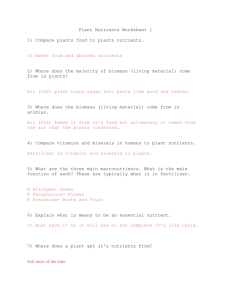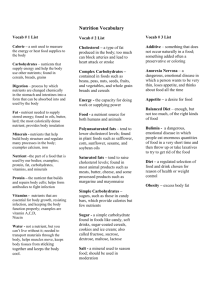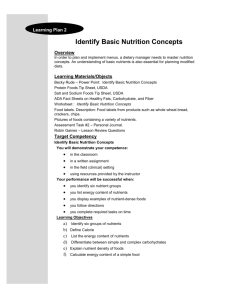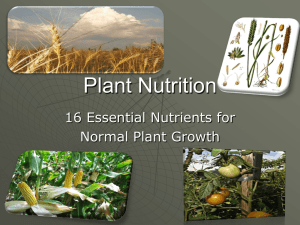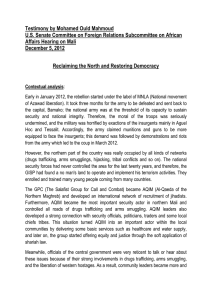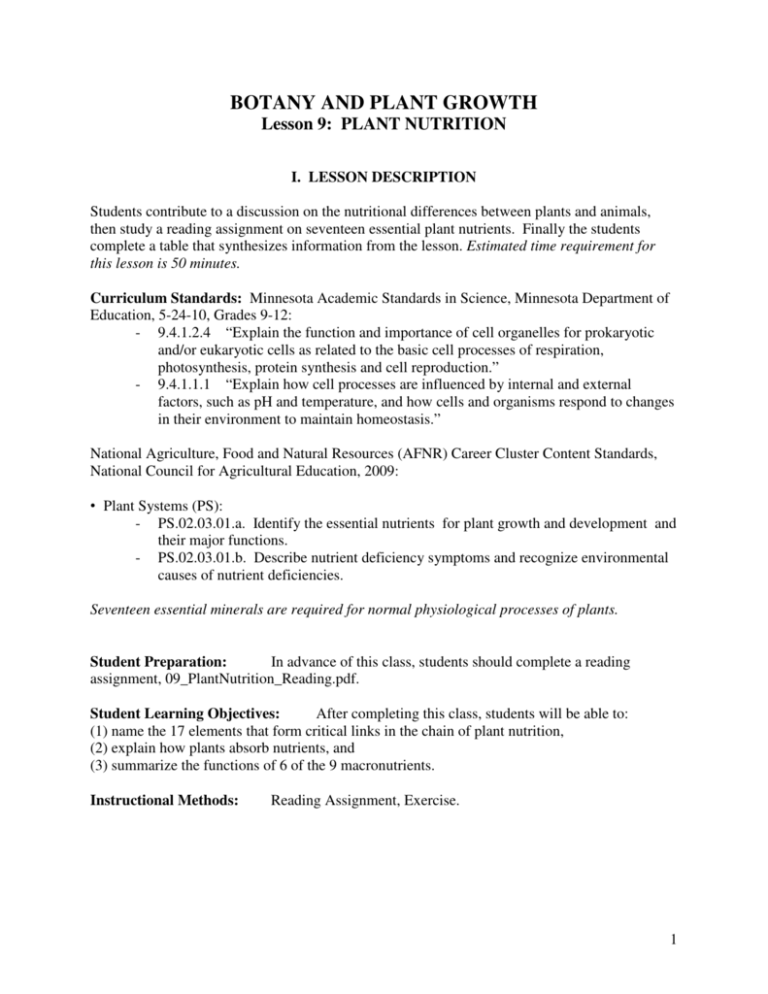
BOTANY AND PLANT GROWTH
Lesson 9: PLANT NUTRITION
I. LESSON DESCRIPTION
Students contribute to a discussion on the nutritional differences between plants and animals,
then study a reading assignment on seventeen essential plant nutrients. Finally the students
complete a table that synthesizes information from the lesson. Estimated time requirement for
this lesson is 50 minutes.
Curriculum Standards: Minnesota Academic Standards in Science, Minnesota Department of
Education, 5-24-10, Grades 9-12:
- 9.4.1.2.4 “Explain the function and importance of cell organelles for prokaryotic
and/or eukaryotic cells as related to the basic cell processes of respiration,
photosynthesis, protein synthesis and cell reproduction.”
- 9.4.1.1.1 “Explain how cell processes are influenced by internal and external
factors, such as pH and temperature, and how cells and organisms respond to changes
in their environment to maintain homeostasis.”
National Agriculture, Food and Natural Resources (AFNR) Career Cluster Content Standards,
National Council for Agricultural Education, 2009:
• Plant Systems (PS):
- PS.02.03.01.a. Identify the essential nutrients for plant growth and development and
their major functions.
- PS.02.03.01.b. Describe nutrient deficiency symptoms and recognize environmental
causes of nutrient deficiencies.
Seventeen essential minerals are required for normal physiological processes of plants.
Student Preparation:
In advance of this class, students should complete a reading
assignment, 09_PlantNutrition_Reading.pdf.
Student Learning Objectives:
After completing this class, students will be able to:
(1) name the 17 elements that form critical links in the chain of plant nutrition,
(2) explain how plants absorb nutrients, and
(3) summarize the functions of 6 of the 9 macronutrients.
Instructional Methods:
Reading Assignment, Exercise.
1
II. LESSON PLAN
Introduction
Legend:
Text in normal face - Represents teacher's words.
Text in italic face - Represents suggestions for the teacher.
Interest Approach:
QUESTION: Bring back to mind what you’ve learned about photosynthesis. When it
comes to food, what is the chief difference between plants and animals?
ANTICIPATED RESPONSES: (Students provide opinions, and if the correct answer is
not found, counter with this question.) Think about the source of that food. We use
plants as food, but what do plants use as food, and where do they find it?
ANSWER: One of the major differences between plants and animals is the plant’s ability
to manufacture its own food. Most plants use light energy to convert carbon dioxide from
the air, and water from the soil, into organic compounds for the plants’ source of energy;
animals, however, must procure external supplies of sugars or other compounds as a
source of energy. Plants can also synthesize all of their required amino acids and
vitamins, while animals must find them in external sources. In spite of this divergence,
there is an interesting convergence: Both plants and animals share the need for water and
certain chemical elements for metabolism, and those elements are the subject of today’s
lesson.
QUESTION: If we give a plant some fertilizers – or minerals – or nutrients – or
whatever we name them, can we say we’re feeding a plant?
ANTICIPATED RESPONSES: Entertain a few responses, but resolve the semantics
before too long, with the answer below.
ANSWER: There’s an expression, “We don’t feed plants (but plants feed us).” Many
people confuse plant nutrition with plant fertilization. Plant nutrition refers to the needs
and uses of the basic chemical elements in the plant. Fertilization is the term used when
these materials are supplied to the environment around the plant. A lot must happen
before a chemical element supplied in a fertilizer can be taken up and used by the plant.
Fertilizers are not plant food! Although it is common practice for many fertilizers to be
called plant food, this is a misnomer. Plants produce their own food using water, carbon
dioxide and energy from the sun.
2
If we intend to understand and improve plant growth, then we have to know which
nutrients a plant needs to combine with its self-made food, in order to produce protein,
enzymes, vitamins, and other elements essential to plant growth.
Relevancy:
In this lesson we’ll learn about the critical importance of the 17 nutrients that are
essential to a plant.
Learning Objectives:
After attending this class, you will be able:
(1) to name the 17 elements that form critical links in the chain of plant nutrition,
(2) to explain how plants absorb nutrients, and
(3) to summarize the functions of 6 of the 9 macronutrients.
Now let’s move into a study session on these nutrients.
Instructional Methods
Reading Assignment: 10 minutes estimated
Students can review their reading assignment, 09_PlantNutrition_Reading.pdf.
Please review your handout. You’ll have 10 minutes.
Exercise: 30 minutes estimated
Distribute to each student a copy of the exercise, 09_PlantNutrition_Task.pdf.
As you studied the lesson you probably noticed that some elements are less likely to be
deficient. Place an asterisk before the nutrients that typically are present in sufficient
amounts in air, water, and Pennsylvania soils.
Then underline the elements without asterisks; levels of the underlined elements will
need to be monitored more closely, since the likelihood of deficiency is greater in the
underlined elements. Refer to your reading assignment to complete the table. Then
follow the three instructions at the bottom of the handout. You’ll have 10 minutes.
Allow time to complete the table, up to 10 minutes. Meanwhile, use the blackboard or
whiteboard to recreate the table found in the student handout (not your answer sheet.)
What have you found? Which elements should have asterisks? Which elements are
underlined? Which element is associated with vegetative growth, and with the cell wall,
and with chlorophyll?
3
Record all class input on your large diagram, then check that your large diagram
matches your answer sheet, 09_PlantNutrition_TaskTEACHER.pdf. If you make any
corrections, discuss why.
Conclusion
You’ve completed a valuable synthesis of data from the text. As you observe a
deficiency symptom in a plant, and attempt diagnosis, hopefully your detective work will
be quicker and easier if you can focus on theories of highest probability. However,
always bear in mind that each and every one of the 17 nutrients is essential, and don’t
rule out the possibility that the missing link in the chain might just be the nutrient that
you least suspect.
Your new insight into the building blocks of plant health will help you build valuable
diagnostic skills in maintaining the health of a plant, whether you garden as a hobby, or
become a professional nursery grower/professional or landscaper.
In the next lesson, we’ll focus on the medium for many of these essential nutrients – the
soil.
4
OPTIONAL ACTIVITIES
•
•
•
•
Have the students thoroughly filter “Segment Three – Nutrient Summaries” in the reading
assignment and list the various deficiency symptoms for each nutrient. Then take a walk
with the students around the property to identify plant parts that show these deficiencies.
If leaves are already turning to their autumn hues, or if they have fallen, then you can
guide a similar study lab with potted plants that could be brought to class. Alternatively,
assign student homework to collect plant parts with various symptoms; however,
diagnosis is more thorough when you can study the entire plant and its environment; to
compensate, the students can take field notes of the environments where they found the
items, and the conditions of the plants.
Consider doing a soil test. The Soil Testing Laboratory at the University of Minnesota
offers soil testing. As a group, follow the instructions on the website to collect samples of
soil, mail them in, then evaluate the results as a group when you receive the report. You
can use the exercise just to experience the process of a test, or you can add interest by
testing the soil in an area where vegetation is particularly luxuriant or problematic. For
more information, visit their website at http://soiltest.cfans.umn.edu/index.htm.
Have the students thoroughly filter “Segment Three – Nutrient Summaries” in the reading
assignment and list nutrients that tend to leach easily from soils, and those that tend
toward little movement.
Assign the students a research project to explore the process of nitrogen fixation. The
self-sufficiency of plants is particularly impressive in this process, since nitrogen-fixing
bacteria convert nitrogen from the air into forms of nitrogen used during the synthesis of
amino acids and proteins.
RESOURCES
Books:
• Biology of Plants, Seventh Edition (December 17, 2004), by Peter H. Raven, Ray F.
Evert, Susan E. Eichhorn. Publisher: W. H. Freeman; Hardcover: 944 pages. ISBN:
0716710072 - Comprehensive book on botany.
09_PlantNutrition_LessonPlan.pdf
5
Thank you for using the Pathways through
Horticulture Curriculum, provided to
Minnesota teachers free-of-charge, courtesy
of the Minnesota Nursery & Landscape
Association and the MNLA Foundation.
For more information or questions, or to inquire about other resources offered by
the MNLA Foundation, please contact:
MNLA Foundation Program Coordinator
Office: 651-633-4987
Email: MNLA@MNLA.biz
www.MNLAschoolhouse.org – Connect with horticulture and landscaping
resources.
www.theLandLovers.org – Your resource for careers in the green industry.
These lessons were obtained through a purchase agreement between the Minnesota Nursery and Landscape
Association (MNLA) and the Pennsylvania Landscape and Nursery Association (PLNA) and have been modified by
the MNLA. The Pennsylvania Landscape and Nursery Association retains all original ownership rights and all
copyrights.
© 2005, Pennsylvania Landscape and Nursery Association. All Rights Reserved.


